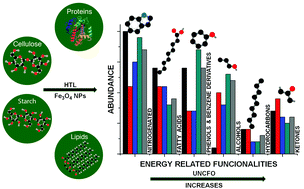Catalytic effect of ultrananocrystalline Fe3O4 on algal bio-crude production via HTL process†
Abstract
We report a comprehensive quantitative study of the production of refined bio-crudes via a controlled hydrothermal liquefaction (HTL) process using Ulva fasciata macroalgae (UFMA) as biomass and ultrananocrystalline Fe3O4 (UNCFO) as catalyst. X-ray diffraction and electron microscopy were applied to elucidate the formation of the high-quality nanocatalysts. Gas chromatography-mass spectroscopy (GC-MS) and CHNS analyses showed that the bio-crude yield and carbon/oxygen ratios increase as the amount of UNCFO increases, reaching a peak value of 32% at 1.25 wt% (a 9% increase when compared to the catalyst-free yield). The bio-crude is mainly composed of fatty acids, alcohols, ketones, phenol and benzene derivatives, and hydrocarbons. Their relative abundance changes as a function of catalyst concentration. FTIR spectroscopy and vibrating sample magnetometry revealed that the as-produced bio-crudes are free of iron species, which accumulate in the generated bio-chars. Our findings also indicate that the energy recovery values via the HTL process are sensitive to the catalyst loading, with a threshold loading of 1.25 wt%. GC-MS studies show that the UNCFO not only influences the chemical nature of the resulting bio-crudes and bio-chars, but also the amount of fixed carbons in the solid residues. The detailed molecular characterization of the bio-crudes and bio-chars catalyzed by UNCFO represents the first systematic study reported using UFMA. This study brings forth new avenues to advance the highly-pure bio-crude production employing active, heterogeneous catalyst materials that are recoverable and recyclable for continuous thermochemical reactions.


 Please wait while we load your content...
Please wait while we load your content...